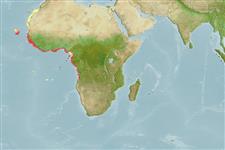Environment: milieu / climate zone / depth range / distribution range
экология
морской демерсальный; пределы глубины 20 - 300 m (Ref. 127989). Tropical; 33°N - 13°S, 27°W - 15°E (Ref. 5222)
Eastern Atlantic: Western Sahara to Angola, including Cape Verde and the Sao Tome and Principe islands. Also recorded from the Mediterranean.
Length at first maturity / Size / Вес / Возраст
Maturity: Lm 18.0 range ? - ? cm
Max length : 70.0 cm TL самец/пол неопределен; (Ref. 27000); common length : 40.0 cm TL самец/пол неопределен; (Ref. 26999)
Краткое описание
определительные ключи | морфология | морфометрия
колючие лучи спинного плавника (общее число) : 9; членистые (мягкие) лучи спинного плавника (общее число) : 15 - 16; колючие лучи анального плавника: 3; членистые (мягкие) лучи анального плавника: 9 - 10. Distinguished by the following characteristics: body depth less than head length, 2.8-3.2 in SL; head length 2.7-3.0 in SL; interorbital area convex; rounded preopercle, finely serrate, with shallow notch, fleshy lower edge; subopercle and interopercle with few small serrae covered by skin; maxilla reaching vertical at rear edge of eye or beyond; pectoral fins longer than pelvic fins, pectoral fin length contained 1.5-1.7 in HL; pelvic fins reaching or nearly reaching anus; caudal fin rounded; lateral-body scales ctenoid, without auxiliary scales (Ref. 089707).
Found on sandy and rocky bottoms (Refs. 32181, 127989). Diandric protogynous hermaphrodite (Ref. 089707).
Life cycle and mating behavior
Maturities | размножение | Spawnings | Egg(s) | Fecundities | личинки
Pelagic spawner (Ref. 32181). Low ratio of males in population correlated with polygamy (Ref. 32181). This study (Ref. 32181), concluded that some males of C. taeniops may not pass through a functional female stage as observed in most groupers, and that these males may have developed directly from immature females conferring with the hypothesis of Shapiro (1987). Diandric (Ref. 103751).
Heemstra, P.C. and J.E. Randall, 1993. FAO Species Catalogue. Vol. 16. Groupers of the world (family Serranidae, subfamily Epinephelinae). An annotated and illustrated catalogue of the grouper, rockcod, hind, coral grouper and lyretail species known to date. Rome: FAO. FAO Fish. Synop. 125(16):382 p. (Ref. 5222)
Статус Красного Списка МСОП (Ref. 130435)
Угроза для людей
Harmless
Использование человеком
рыболовство: не имеет хозяйственного значения
дополнительная информация
инструменты
Специальные отчеты
Скачать в формате XML
ресурсы в Интернет
Estimates based on models
Preferred temperature (Ref.
123201): 15.8 - 20.7, mean 19.2 °C (based on 47 cells).
Phylogenetic diversity index (Ref.
82804): PD
50 = 0.5000 [Uniqueness, from 0.5 = low to 2.0 = high].
Bayesian length-weight: a=0.00977 (0.00645 - 0.01482), b=3.10 (2.98 - 3.22), in cm total length, based on LWR estimates for this species & Genus-body shape (Ref.
93245).
Trophic level (Ref.
69278): 4.5 ±0.80 se; based on food items.
Generation time: 8.1 ( na - na) years. Estimated as median ln(3)/K based on 2
growth studies.
устойчивость к внешним воздействиям (Ref.
120179): низкий, минимальное время удвоения популяции 4.5-14 лет (Preliminary K or Fecundity.).
Fishing Vulnerability (Ref.
59153): High vulnerability (56 of 100).
Nutrients (Ref.
124155): Calcium = 82.6 [45.8, 179.5] mg/100g; Iron = 0.778 [0.383, 1.684] mg/100g; Protein = 17.9 [16.1, 19.6] %; Omega3 = 0.273 [0.144, 0.501] g/100g; Selenium = 83.4 [38.1, 179.9] μg/100g; VitaminA = 22.7 [7.7, 77.2] μg/100g; Zinc = 0.732 [0.466, 1.255] mg/100g (wet weight);
